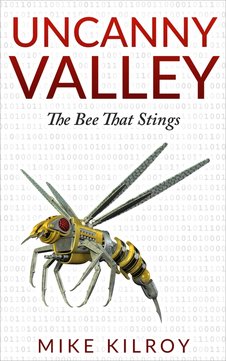 Mark Twain once said that the two most important days in life are the day you are born and the day you discover the reason why. Addis can recount the day of his birth with apt precision. It is just one of many facts in his arsenal that he can regurgitate at will. However, discovering the reason for his existence is proving rather tricky. In the second installment of Mike Kilroy’s Uncanny Valley trilogy – aptly titled Uncanny Valley: The Bee That Stings – an android named Addis continues his journey of self-discovery and desired acceptance by those who would try to keep him and his kind from achieving equality and freedom. Although set in the future in San Francisco, the series parallels many of the struggles minorities and immigrants are facing today – to be valued, to be accepted and to have the same opportunities as others. The first book in the Uncanny Valley trilogy forced the cannies to the ultimate realization that if they wanted to be viewed as equals, it was a privilege for which they would have to be willing to fight. Fueled by this deep-seated desire to be accepted – combined with a weariness for being disparaged and degraded by humans – Addis and the cannies launch headlong into war with their human oppressors at the end of the first book in the series. As part of their battle, the androids find a way to reprogram themselves to enable them to be more like the humans they were modeled after, including the ability to experience human emotions. But because the “Gen-One” androids were never built to withstand the burden that comes along with exhibiting emotion over pure logic, they face possible extinction as their newfound emotional abilities spiral out of control. Part one of Uncanny Valley is available on Amazon. My review of part one of the trilogy is available here. As readers rejoin the fight in Uncanny Valley: The Bee That Stings, we find the creator of the cannies, Max Bedard, stumbling across one of his creations in an anger-filled scene on the streets of San Francisco. Longing to leave the underground “paradise” he and a select few escaped to during the height of the tensions with the cannies in book one, Bedard heads to the surface in search of the luxuries – like feeling real sunlight on his face and tasting an orange – he has been lacking during his underground exile. Among the first scenes he stumbles on during his above-ground excursion is a group of teens viciously attacking an android. . . . With each jab that sent the android’s head snapping back, the teens taunted him. The blows had little effect on him physically or mentally, it seemed—the synthetic man absorbed the punches without any outward damage, and he did so calmly. His demeanor became more cold, however, with each blow and burst of laughter. Max kept moving. A loud shriek startled Max and his head swiveled. The android had his hand squeezed around the neck of one of the boys. He stood, lifting the teen a foot off the pavement. The other boy futility kicked at the android’s shin. “Let him go, Cannie!” the teenager screamed and the android released his grip. The boy crumpled to the sidewalk with a loud thud. He coughed and grasped at his ruddy neck, and then stood and ran, his friend following closely behind. The android’s eyes locked on Max. There was deep hatred in them and it disturbed Max. He slowly approached the android, who stood his ground, puffing his chest out, widening his stance, preparing for battle. Max held his hands up as a show of peace. “I’m not gonna attack you.” “That would be a wise course of action.” “You could have killed that boy.” “But I did not.” “Why were they attacking you?” “You do not know?” “I’ve been … out of town for a while.” The android pointed to two signs turned face down on a patch of grass near the sidewalk. Max grabbed one and flipped it over. His eyes rolled over the bold, block words. CULL THE CANNIES! He picked up the other sign. DESTROY THE OBAMANATIONS. “They spelled abominations wrong,” Max whispered. “They want to exterminate us. They will not succeed. We are not going anywhere.” It is difficult for Bedard to see his beloved creations reduced to feelings of uncontrollable rage and heightened emotions that they cannot control. It is even more painful for him to realize that someone has made it a priority to “cull the cannies.” That someone is Mark Ehlo, whose initials – M.E. – are a pretty accurate description for his personality. Ehlo has not only started a movement that encourages followers to destroy cannies one by one – but he also encourages his followers to send him tributes consisting of dismantled cannie body parts in boxes that are marked “M.E.” Ehlo has made it acceptable – even fashionable to a degree – to not only dislike the cannies, but to feel justified in their utter destruction. “Mark Ehlo cares about only one thing: Mark Ehlo,” said Kilroy. “He even wants his tributes to be marked with M.E. to highlight his self-importance and arrogance. Not that readers needed any more clues to his obvious character flaw, but ‘M.E.’ kind of brought it all home.” Kilroy also presents readers with an unexpected twist where their beloved Addis is concerned – one that is a warning to be careful what you wish for, because you just might get it. I don’t want to spoil this twist in my review, because I believe to do so would truly ruin the enjoyment of readers if they know about it in advance. It’s safe to reveal that this twist brings an added level of tension between Addis and Bedard’s daughter, Renae. “Addis is an interesting character because he is very much caught between two worlds,” said Kilroy. Addis is not the only one who is coming to grips with the reality of who – and what – he has become. Several characters in The Bee That Stings will find themselves faced with the same harsh reality, with nowhere to run or hide from themselves. Kilroy already is plotting his third and final installment of the Uncanny Valley trilogy, which he plans to release this fall. Uncanny Valley: The Bee That Stings is available now on Amazon.
0 Comments
Your comment will be posted after it is approved.
Leave a Reply. |
Categories
All
Archives
April 2024
|
